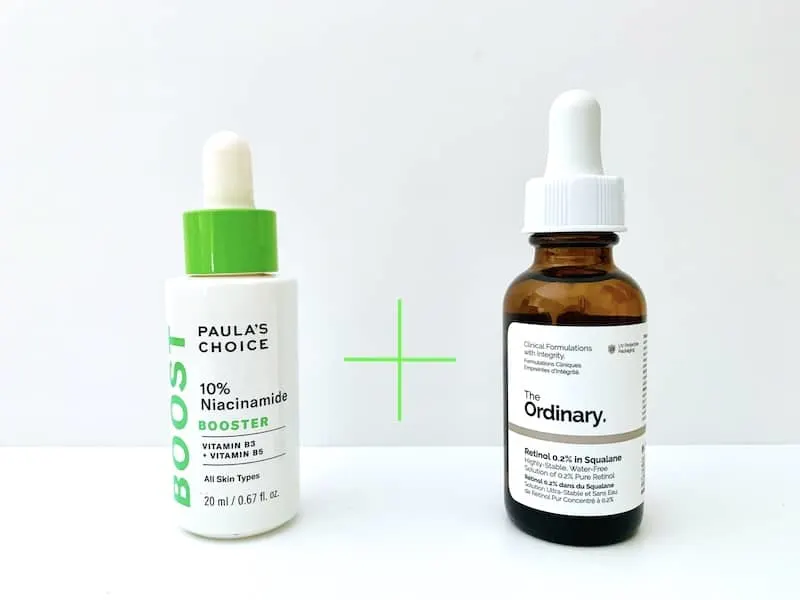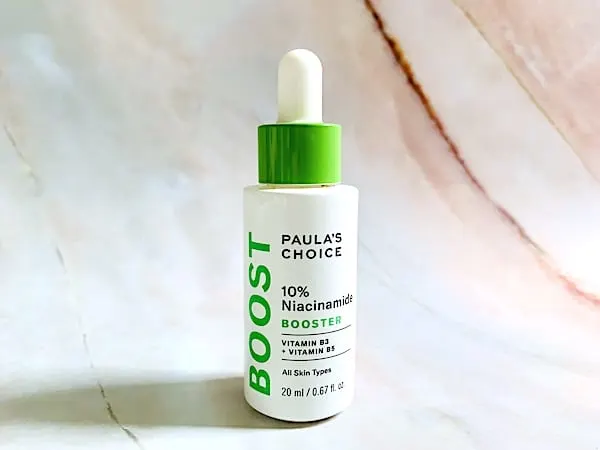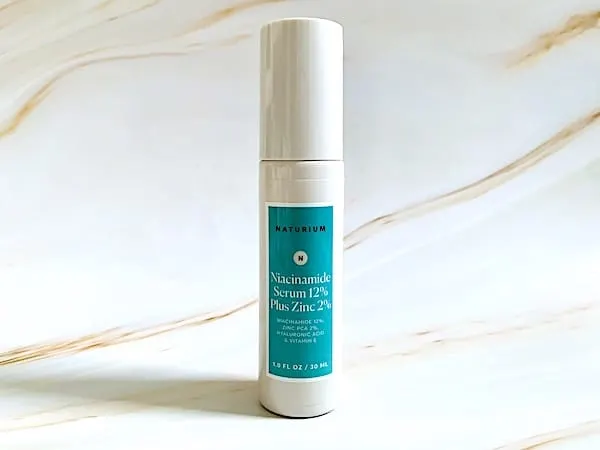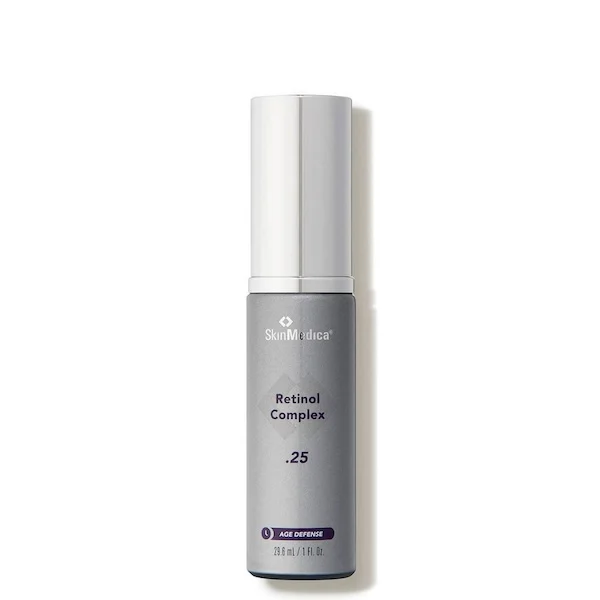If you’ve ever wondered if you can use niacinamide with retinol together in the same skincare routine, you’ll be glad to know that the answer is YES! These active ingredients share a similar pH and work together to improve the visible signs of aging.

Jump Ahead To:
Can You Use Niacinamide with Retinol?
You can use niacinamide and retinol together. Both niacinamide and retinol offer multiple benefits for the skin.
These benefits overlap when it comes to anti-aging, so using niacinamide and retinol together can strengthen each other’s formulas, creating a powerhouse duo that targets multiple signs of aging.
This post on using niacinamide with retinol contains affiliate links, and any purchases made through these links will result in a commission for me at no extra cost to you. Please read my Disclosure for additional information.
The Benefits of Retinol and Niacinamide
You may be wondering why you should use retinol or niacinamide, so let’s look at some of the benefits of both active ingredients.
The Benefits of Retinol
Retinol, a form of vitamin A, is one of the most potent over-the-counter actives that reduces fine lines, wrinkles, dullness, hyperpigmentation, dark spots, and uneven skin tone, thanks to its ability to stimulate collagen synthesis and increase cell turnover.
It also helps to improve skin texture and brighten the skin.
Retinol can even help to reduce acne since it works to unclog pores and has anti-inflammatory properties.
With so many amazing anti-aging benefits, unfortunately, retinol does have its drawbacks. Depending on the strength, retinol can irritate and cause dryness and redness if your skin has not built a tolerance to it.
Yet, over-the-counter retinol is less irritating than the strongest retinoids, and new types of encapsulated delivery systems help minimize the side effects of retinol.
If you are a beginner retinol user, be sure to start slow to give your skin a chance to acclimate to this potent active ingredient.
Also, remember to keep your skin hydrated and moisturized while using retinol with products containing ingredients such as hyaluronic acid and ceramides.
It is also important to apply a broad-spectrum sunscreen with an SPF of 30 or higher when using retinol and other retinoids and seven days after since retinol can make your skin sensitive to the sun.
The Benefits of Niacinamide
Niacinamide, a form of vitamin B3, is one of the most potent multi-benefit skincare actives available. Niacinamide has antioxidant properties and offers a host of benefits when it comes to the signs of aging.
Niacinamide soothes dry skin and helps to improve epidermal barrier function by decreasing transepidermal water loss.
It does this through an increase in ceramide production and cell turnover to remove dead skin cells.
Niacinamide decreases hyperpigmentation, fine lines and wrinkles, blotchiness, and sallowness.
Niacinamide’s antioxidant properties help to protect skin from damaging UV rays.
Niacinamide protects skin from free radicals, which lead to visible signs of aging, including fine lines, wrinkles, and hyperpigmentation.
Niacinamide also boosts collagen production, which helps improve firmness and skin elasticity.
Niacinamide is an active ingredient that also works as an anti-inflammatory and calms the skin.
Niacinamide has even been shown to be an effective treatment for melasma as it reduces pigmentation and inflammation.
If you suffer from acne or have oily skin, niacinamide can help regulate sebum production, reducing acne and breakouts.
The Benefits of Niacinamide and Retinol When Used Together
Of direct importance to this conversation about using niacinamide and retinol together is niacinamide’s ability to protect skin from certain topical agents, like, none other than retinol!
When used together, niacinamide can help to reduce the irritation associated with retinol and retinoid use.
This study examined the use of tretinoin, a prescription-strength form of Vitamin A, which is much stronger the retinol.
It determined that using a moisturizer containing vitamins, including niacinamide, panthenol, and tocopheryl acetate, before and during tretinoin use, improved barrier function, tolerability, and treatment response.
Another study showed that when treating subjects for photodamage, retinol yielded better tolerability when used with moisturizing actives, including niacinamide.
While retinol’s optimal pH is 5.5 – 6.0, niacinamide is most viable around 6.0, so unlike other actives that don’t play well together, niacinamide and retinol work synergistically and won’t cancel out each other’s benefits.
Retinol and Niacinamide: A Double Whammy for Acne
As noted earlier, retinol and retinoids can help to reduce acne by increasing unclogging pores, increasing cell turnover, and decreasing inflammation.
Niacinamide is also helpful for acne-prone skin since it lowers sebum excretion rates and levels and helps to reduce the appearance of pores.
This study demonstrated that nicotinamide (niacinamide) at 4% was as effective as 1% clindamycin gel in the treatment of acne.
When used together, Niacinamide and retinol help to increase cell turnover, which helps to unclog pores and reduce the look of acne scars and hyperpigmentation.
Plus, they both have anti-inflammatory properties to soothe redness caused by acne and acne scars.
When to Use Retinol and Niacinamide
Using niacinamide for a few weeks before starting a retinoid regimen can strengthen the skin barrier and prep it for retinoid use.
When using retinol and niacinamide in the same skincare routine, they should be applied in your PM skincare routine because retinol can cause sensitivity to the sun.
Although you are applying these products at night, it is still important to wear a broad-spectrum sunscreen with an SPF 30 or higher and for seven days after.
TIP: For additional anti-aging and antioxidant benefits, use a vitamin C serum or cream in your morning skincare routine.
What Order to Use Retinol and Niacinamide
If you are wondering whether to use niacinamide before or after retinol, it depends on the type of product you are using.
If you use a niacinamide serum and a retinol moisturizer, use the niacinamide serum first since serums are usually applied before moisturizers.
If you are using niacinamide and retinol at the same time and they are both in serum format, you may want to apply the niacinamide serum first to act as a buffer to minimize skin irritation and redness that a retinol serum can cause.
Adding niacinamide into your retinol routine can especially benefit those with sensitive skin.
Can I Use Retinol, Niacinamide and Hyaluronic Acid Together?
Yes, you can use all three active ingredients together. If you choose to replenish moisture with a hyaluronic acid serum in addition to niacinamide serum and retinol serum, consider applying hyaluronic acid first to give your skin a moisture boost and then follow with niacinamide and finally retinol.
Related Post: Drmtlgy Needle-Less Serum Review
Retinol and Niacinamide Products To Try
Paula’s Choice 10% Niacinamide Booster

Paula’s Choice 10% Niacinamide Booster contains 10% niacinamide (vitamin B3) and replenishing actives to brighten, protect, calm, and hydrate the skin.
It works on uneven skin tone, rough skin texture, redness, and dryness, for a more radiant complexion.
This niacinamide serum also contains ascorbyl glucoside, a vitamin C derivative that offers antioxidant and brightening benefits.
Sodium hyaluronate (the salt form of hyaluronic acid) hydrates while ubiquinone, epigallocatechin gallate, beta-glucan, carnosine, and genistein provide antioxidant protection.
The serum is extremely lightweight, so it is ideal for layering under other skincare products. It is so light that you can apply it under retinol without interfering or causing pilling under other skincare products.
Due to the lightweight formula, you can mix this serum with moisturizer to provide a brightening and soothing boost.
If you add it to a moisturizer and use it with a retinol serum, apply the retinol serum first and then follow with moisturizer.
Naturium Niacinamide Serum 12% Plus Zinc 2%

For a less expensive niacinamide serum, Naturium Niacinamide Serum 12% Plus Zinc 2% serum is formulated with 12% niacinamide plus 2% zinc PCA (pyrrolidone carboxylic acid) to boost its blemish-fighting abilities with its antibacterial properties.
It also contains hyaluronic acid to plump and hydrate the skin.
The Ordinary Retinol 1% in Squalane

The Ordinary Retinol 1% in Squalane serum contains 1% retinol in a squalane base. It is a water-free solution that helps to reduce the look of the signs of aging, including fine lines and photodamage.
The Ordinary cautions that this serum may cause redness, irritation, and peeling until your skin has built a tolerance to retinol usage.
To avoid this irritation, The Ordinary suggests using their Granactive Retinoids.
The Ordinary’s Granactive Retinoids generally cause little to no irritation, and you can use them with niacinamide to boost anti-aging benefits.
NOTE: This retinol is in a squalane base with a light oil texture. If using with a water-based niacinamide serum, apply the niacinamide serum first and then follow with this retinol in squalane serum.
Related Post: The Ordinary “B” Oil Review
Niaicinamide and Retinol All-In-One Products
CeraVe Retinol Resurfacing Serum

CeraVe Retinol Resurfacing Serum is a best-selling drugstore retinol serum for its ability to target post-acne marks and pore size with retinol and niacinamide.
The serum contains encapsulated retinol to minimize irritation while resurfacing the skin, along with niacinamide to soothe, brighten the skin, and reduce the appearance of pores.
The formula also contains CeraVe’s three essential ceramides, Ceramide NP, Ceramide AP, and Ceramide EOP, to restore and maintain the skin’s protective moisture barrier.
Ceramides are found naturally in the outer layer of our skin and are like the glue that holds skin cells together. When they’re depleted, skin can become dry, irritated, and more prone to wrinkles.
This retinol serum also contains sodium hyaluronate to attract hydration to the skin and help it retain moisture.
Dipotassium glycyrrhizate, an anti-inflammatory ingredient from the licorice plant, helps soothe the skin and also helps regulate oil production in the skin, which is beneficial for those who have oily and acne-prone skin.
The serum is non-comedogenic (won’t clog pores), paraben-free, and fragrance-free, and uses CeraVe’s MVE Technology to release moisturizing ingredients over time for optimal absorption into the skin.
This serum helps fade acne marks over time and leaves skin looking smoother and brighter with improved skin texture and tone.
It’s a great starter retinol serum, and it’s available at affordable drugstore prices.
Related Post: The Best Avène Products
SkinMedica Age Defense Retinol Complex .25

If you want to use a single luxury product to get the benefits of both niacinamide and retinol, SkinMedica Age Defense Retinol Complex .25 is an excellent option.
This retinol skincare product improves skin tone, texture, and resiliency with a slew of active ingredients, including niacinamide, retinol, squalane, a ceramide, vitamin E, and plant extracts.
Niacinamide and retinol work together to increase skin cell turnover and reduce the appearance of fine lines and coarse wrinkles while brightening dull skin.
The serum uses SkinMedica’s proprietary PhytoShield Complex, an antioxidant complex that improves skin texture while minimizing irritation.
NOTE: SkinMedica also offers stronger versions of this serum: SkinMedica Retinol Complex 0.5 concentration and SkinMedica Retinol Complex 1.0.
Related Posts: The 10 Best Body Lotions for Crepey Skin on Arms and Legs in 2021, Crepe Erase Review
Niacinamide and Retinol: Better Together!
If you’ve ever wondered to yourself: “can I use niacinamide with retinol?” now you know, yes, you can!
While niacinamide and retinol offer multiple skincare benefits on their own, when used together, you really ramp up their effectiveness and minimize retinol’s side effects, including irritation, redness, and peeling.
Thanks for reading, and here’s to your good skin health!
Related Posts on Using Actives Together:
